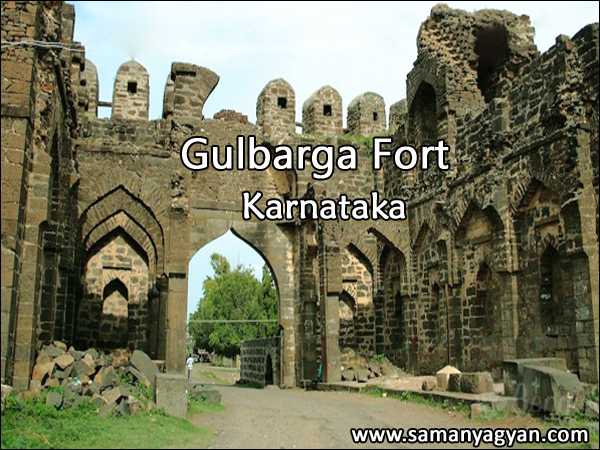Gulbarga Fort Quick Facts
| Place | Gulbarga District, Karnataka (India) |
| Built in | 14th century AD |
| Built by | Al-ud-din Bahmani and Adil Shah |
| Type | Fort |
Gulbarga Fort Overview
Located in the south of the Indian subcontinent, the state of Karnataka is one of the most prominent states of India, Gulbarga Fort, located in the Gulbarga district of this state, is one of the most ancient and carved forts in India, known for its historical culture and artwork in the world.
Gulbarga Fort History
The Gulbarga region was ruled by the Hoysala dynasty till the end of the 12th century. It was during his reign that the Kakatiya dynasty was also becoming powerful, which later captured Gulbarg district and Raichur district. After defeating the Kakatiya dynasty in the year 1321, the Delhi Sultanate started its rule over this region.
The Bahmani Sultanate was established in the year 1347 on the revolt of the Muslim officers appointed from Delhi, its First king Hasan Gangu chose Gulbarga as his capital, who also built this fort. Later, when the capital was shifted to Bidar, it brought changes in the social, cultural and religious life of the Deccan due to which they started mixing with Hindu traditions.
Gulbarga Fort was destroyed by the emperor of Vijayanagara. Later, when Yusuf Adil Shah became the emperor here, he got it rebuilt. The Deccan was largely ruled by the Bahmani kingdom until the end of the 15th century and the beginning of the 16th century, after which the kingdom was divided into five parts. After this it was captured by the Mughal Emperor Aurangzeb and Nizam-ul-Mulk was appointed here to oversee it.
When the Mughal Empire collapsed in the early 18th century, Nizam-ul-Mulk Asafjah established the Hyderabad state in 1724, with a large area of Gulbarga being part of this empire.
Gulbarga Fort Interesting Facts
- This grand and historical fort was built around 14th century by al-ud-din Bahmani and Adil Shah.
- The Bahmani sultanate that built this fort was the first independent Islamic sultanate in the Deccan of South India to establish its own kingdom, this sultanate is considered one of the great medieval Indian kingdoms.
- In this fort, the longest cannon of Gulbarga Fort was built in the 14th century by the Turkish people during the rule of the Bahmani Empire, which was made of alloy (Panch Dhatu).
- The name of the cannon installed in this fort is "Bara Ghazi Cannon", which is 29 feet long and 7 inches thick. The circumference of this cannon is 7.6 feet and the diameter is about 2 feet.
- The Mughal emperor Aurangzeb captured this fort in the year 1687 and appointed Asfah I ("Nizam-ul-Mulk") as the governor of the Deccan, who took over the reins of this fort.
- After India became independent in August 1947, Hyderabad State (Gulbarga) was annexed to the Indian Union in the year 1948 and Hyderabad was partitioned on linguistic lines in 1956, after which it was renamed as Andhra Pradesh.
- Fort is located in an arid region, which is known by experiencing rainfall only for 46 days of the year, this fort saves only 30.6 inches of water in only 46 days of rain.
- Fort is covered over an area of only 0.20 hectares, the total length of which is 3 km.
- This fort is made of 2 storeys, which is very well surrounded by the outer security wall.
- Like other famous forts of India, this fort is surrounded by a meadow of about 30 feet wide.
- The fort is a massive structure in Karnataka, with 15 towers for 26 cannons built very strongly.
- The length of each cannon inside this fort is about 8 meters and all these are well preserved even today.
- The First mosque in South India was built by the Bahmani Sultanate in Gulbarga which is known as "Jama Masjid", this mosque is the only mosque of its kind in India, which is about 216 feet long and 176 feet high.
- The front verandah of the Kaaba-faced wall of this mosque houses nine chambers, on top of which a large carved dome has been built.
- There are a total of 5 big domes, 75 small domes and about 250 arches located in this mosque, which are built in typical Persian architectural style.
- The other most prominent structure of this fort is the tomb of Khwaja Bande Nawaz, which is built in the Indo-Muslim style of architecture. The most important thing about this structure is that in 1413 AD, the famous Sufi saint Sayyid Muhammad Gesu had come here.

